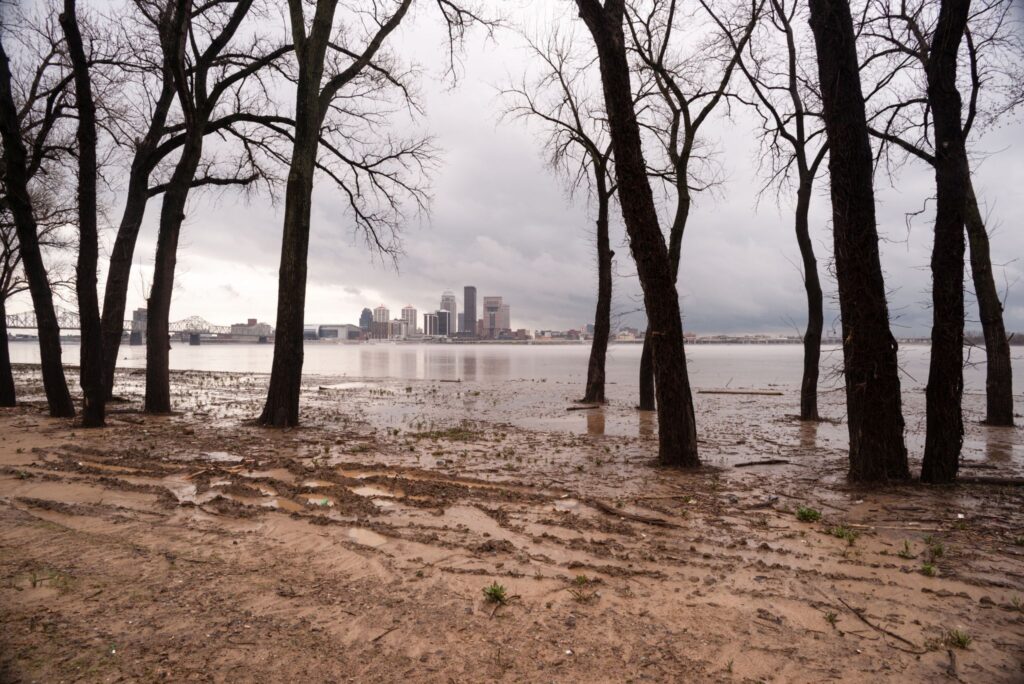Kentucky Flash Flood Protection
Kentucky flash flood scenarios are only expected to increase in the coming years due to climate change. TrapBag flood barriers can help protect your home.

The historic flooding that hit eastern Kentucky in July 2022 claimed the lives of more than 40 people and forced thousands to flee their homes. The immense damages to homes, businesses, and property is still being calculated.
It wasn’t the first major flood to hit residents of Kentucky, and it won’t be the last. Scientists say the number of severe flash floods is expected to increase due to climate change, both in Kentucky and across the world.
Many Kentucky residents are looking for ways they can protect their homes and businesses against future flooding events. TrapBag® provides affordable flood protection barriers that can build an effective and durable wall against floodwaters within hours.
The Kentucky Flooding Map
The most recent flooding in Kentucky occurred in the eastern part of the state since that area had the most rainfall. Some areas around Hazard saw nearly 12 inches of rain within just five days. But there was flooding in multiple locations, and previous floods have often hit the northern part of the state, particularly around Louisville.
What Caused the Flooding in Kentucky?
Unfortunately, several geographic factors make Kentucky particularly vulnerable to flash floods. The state is right in the path of major storms that are created from moisture above the Gulf of Mexico and then are pushed through the hot and dry air above Texas. And while the amount of rain that Kentucky received in such a short period of time would have caused significant flooding problems in just about any area, it was even worse due to Kentucky’s unique challenges.
Kentucky’s terrain is rugged and mountainous, which prevents the ground from being able to quickly absorb any rainfall. Instead, the stormwater ends up heading to the few flat areas of the state, which are also some of the only areas suitable for homes to be built.
How Climate Change Affects Flooding in Kentucky
As the planet gradually warms, more moisture evaporates into the atmosphere, causing more storms and more precipitation. Storms that were previously considered once-in–100-year floods are happening more frequently. A state assessment performed in 2018 predicted that Kentucky flooding would increase over time.
But much of the state’s flood prevention infrastructure was built in the 1960s and 1970s when flood risks were not as severe as they are now. Those flood control methods will not be able to handle the level of flooding that is likely to take place going forward. Many infrastructure pieces will need to be upgraded or supplemented with additional flood barriers.
The History of Kentucky’s Flash Flooding
The National Weather Service keeps extensive records on the flooding of Kentucky and other states throughout history. We’re taking a look at some of the biggest floods the state has experienced, though this list is by no means exhaustive.
2022
The flooding in 2022 was the result of a series of “training thunderstorms” that passed over the same parts of the state multiple times, repeatedly drenching them in heavy rainfall. Some parts of Kentucky experienced four inches of rain per hour. For many areas of the state, it was the worst flooding since The Great Flood of 1937.
1997
One of the worst floods to batter Kentucky was in March of 1997 when heavy rainfall fell on large parts of southern and central Kentucky. The Ohio River crested 15 feet higher than the flood stage, affecting tens of thousands of Louisville residents and causing hundreds of millions in damages. A total of 19 people died, and 106 counties across both Kentucky and Indiana were declared disaster zones.
1945
After the Great Flood of 1937, some residents attempted to build flood prevention systems out of sandbags, but they failed during a period of heavy rainfall in 1945. Around 50,000 people were forced to evacuate from their homes, many for the second time in eight years.
1937
When the Ohio River flooded in 1937, it was the worst flood in the recorded history of modern settlement of the area, which stretched back 175 years. After nearly 15 inches of rain in less than two weeks, the crest of the flood was 10 feet higher than any flood that has happened since. Nearly three-quarters of Louisville was underwater, and 175,000 people were evacuated. Around 90% of the city of Jeffersonville, Indiana was flooded, with more than 10,000 people forced to flee. The damages are estimated to be more than $3.3 billion in today’s dollars.
How TrapBag Flood Barriers Can Help
Water Barriers
The flexible design of TrapBag lets them serve in a wide range of flood prevention scenarios, including along rivers, lakes, dunes, and beaches. They have been used temporarily, during hurricanes, or as permanent guards against flooding and erosion.
Dams, Dikes, and Levees
TrapBags can serve as temporary or permanent dams, or they can build height on top of existing dikes or levees. Their simple-yet-effective engineering allows them to create a wall that can stretch for miles if the need calls for it.
Mudslide Protection
In the mountains of Kentucky, mudslides and mudflows are frequent hazards in periods of heavy rainfall. Mudslides are particularly common in the eastern and far northern parts of the state. They kill more than 25 people each year, and the amount of mudslides is expected to increase due to commercial development and heavier rainfalls. It is estimated that mudslides and mudflows cost Kentucky an average of more than $4 million a year.
Residents should pay close attention to areas with steep slopes, especially those that have been modified by human activity. Indicators of a potential mudslide area include tilted trees, telephone poles, or walls. They can also be particularly common on the banks of streams or rivers.
TrapBags can provide effective protection by creating a barrier that can halt and redirect the flow of mudslides. They have been successfully deployed to prevent damage from flooding and mudslides in mountainous areas such as Colorado.
Erosion Control
Severe flooding and mudslides can eat away at the banks of rivers and lakes, and wash away the valuable topsoil that plants need to grow. TrapBags are frequently used to protect areas from erosion by preventing water from flooding the area.
Protect Against the Next Kentucky Flood with TrapBag
If you’d like to learn more about TrapBag flood barriers, we would be happy to discuss how they can solve your specific flood prevention needs. We are available 24/7 at (239) 674-6611.
Meet the author
Get the Dirt Before the Flood Hits
Stay ahead of flooding, erosion, and disaster response challenges. The Dirt, TrapBag’s monthly newsletter, delivers field-tested tips, real-world case studies, and the latest in barrier technology straight to your inbox.

